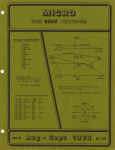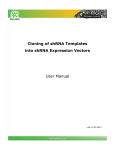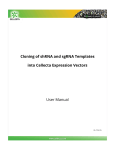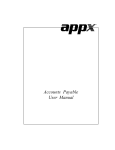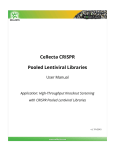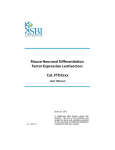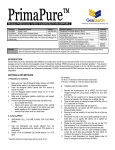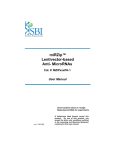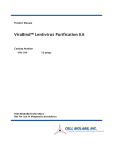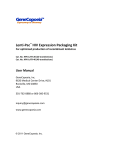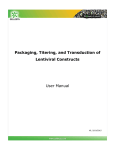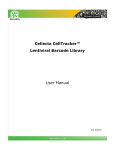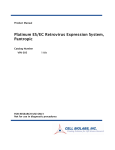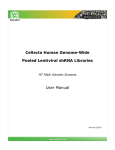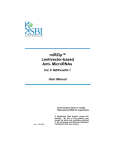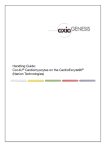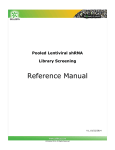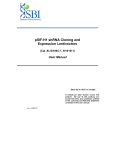Download Cellecta User Manual, Cloning of shRNA Templates into
Transcript
Cellecta, Inc. 320 Logue Ave Mountain View, CA 94043 www.cellecta.com 650-938-3910 Cloning of shRNA Templates into shRNA Expression Vector User Manual Table of Contents Page A. Background 1 B. Required Materials 1 C. Cloning of shRNA Template Oligonucleotides into shRNA Expression Vector 2 D. Identify clones with the target shRNA template 3 E. Purify Plasmid shRNA Construct 4 F. Technical Support 4 G. Safety Guidelines 5 H. References 6 I. 6 Cellecta Limited Use License Agreement A. Background The protocols below provide the instructions on how to phosphorylate shRNA template oligos, ligate them to shRNA cloning vectors, transform competent cells, and grow plasmid DNA to generate plasmid shRNA expression constructs. For packaging of constructs into pseudovirus, please refer to the User Manual for Packaging and Transduction of Lentiviral Constructs. Please read the entire user manual before proceeding with your experiment. B. Required Materials For Phosphorylation and Annealing of shRNA Template Oligonucleotides • • T4 Polynucleotide Kinase and 10X reaction buffer (Recommended: New England BioLabs T4 Polynucleotide Kinase, 10 U/µl, Cat. # M0201S) rATP (Recommended: GE/Amersham, Cat. # 27-2056-01) For Ligating and Transforming shRNA Constructs • • Linearized shRNA Expression Vector NOTE: For DECIPHER™ pRSI9-U6-(sh)-UbiC-TagRFP-2A-Puro Empty Vector (undigested), Cellecta recommends digestion with Fermentas BpiI (Bbsl), [10 U/µl], Cat.# ER1012, and gelpurification using QIAGEN QIAquick Gel Extraction Kit, Cat.# 28706. T4 DNA Ligase and 10X ligation reaction buffer (Recommended: New England BioLabs, T4 DNA Ligase, 400 U/µl. Cat. # M0202S) Before using, dilute T4 DNA-ligase 10-fold with 1X T4 DNA ligase buffer to 40 U/µl.) • • Competent E. coli cells (RecA-) (Recommended: Invitrogen, OmniMAX™ 2 T1 cells, Cat. # C8540-03) Petri plates containing LB Agar media with 100 µg/ml Ampicillin or Carbenicillin For Screening shRNA Inserts • • • Taq DNA polymerase, and 10X reaction buffer (Recommended: BDB Clontech Titanium™ Taq DNA polymerase, Cat. # 639208) dNTP mix (Recommended: GE/Amersham, dNTP set, Cat. # 27-2035-01) Thermal Cycler Tech Support: [email protected] 1 of 6 v.3, 2/7/11 Cellecta, Inc. 320 Logue Ave Mountain View, CA 94043 www.cellecta.com 650-938-3910 • 3% 1X TAE Agarose gel For Purifying shRNA Constructs after Cloning • Plasmid purification kit (Recommended: QIAGEN Endotoxin-free Plasmid Kit. The following kit combinations can be used for Midi scale preparation of endotoxin-free DNA: QIAfilter Plasmid Midi Kit, Cat. # 12243, and EndoFree Plasmid Maxi Kit, Cat. # 12362 QIAfilter Plasmid Midi Kit, Cat. # 12243, and EndoFree Plasmid Buffer Set, Cat. # 19048 Please visit the QIAGEN website to download the specialized protocol that is not contained in the user manual: http://www1.qiagen.com/literature/protocols/pdf/QP15.pdf C. Cloning of shRNA Template Oligonucleotides into shRNA Expression Vector 1. Phosphorylate and Anneal the shRNA Template Oligonucleotides Note: This protocol was developed for regular non-phosphorylated oligos. If your oligonucleotides are already phosphorylated, dilute them to 10 µM in 1X T4 polynucleotide kinase buffer, heat at 95°C for 2 min and anneal as in steps 1.d-1.e below. a. Dissolve the shRNA template oligonucleotides in an appropriate amount of deionized water to a final concentration of 20 µM. b. Set up 20 µl phosphorylation/annealing reactions for each shRNA template: 1 1 2 2 13 1 µl µl µl µl µl µl 20 µl Top Strand shRNA template oligo (20 µM) * Bottom Strand shRNA template oligo (20 µM) * 10X T4 Polynucleotide Kinase Buffer 5 mM ATP Deionized water T4 Polynucleotide Kinase (10 U/µl) Total volume * For the insert-minus control, use 2 µl deionized water in place of the top and bottom strands. c. Incubate the phosphorylation reaction at 37°C for 30 minutes in a thermocycler. d. Heat the reaction mix to 95°C for 2 min in a thermocycler. e. Turn off the thermocycler and let it cool to room temperature. f. Take a 2 µl aliquot from the reaction (1 µM shRNA template), and make a 1:5 dilution by adding 8 µl of 1X T4 Kinase buffer. Mix well. g. Use 0.5 µl of the diluted shRNA template (0.2 µM) for the following ligation reaction. 2. Ligate the shRNA Template into Linearized shRNA Lentivector a. Set up 10 µl ligation reactions for each phosphorylated shRNA template as follows: 1.0 0.5 1.0 6.5 1.0 µl µl µl µl µl 10.0 µl Linearized shRNA Expression Vector (10 ng/µl) (see Required Materials) Phosphorylated ds shRNA template (step 1; 0.2 µM) * 10X T4 DNA Ligase Buffer Deionized water T4 DNA ligase (40 U/µl) ** Total volume Tech Support: [email protected] 2 of 6 v.3, 2/7/11 Cellecta, Inc. 320 Logue Ave Mountain View, CA 94043 www.cellecta.com 650-938-3910 * For negative control use insert-minus. ** Dilute T4 DNA ligase (400 U/µl) 10-fold to 40 U/µl with 1X T4 DNA ligase buffer if you are using New England Biolabs enzyme. b. Incubate the ligation reaction at 16°C for 1-2 hrs. 3. Transform E. coli with the ligation product a. For each shRNA template, use the whole volume of ligation product for transformation. b. Follow the manufacturer’s protocol for transforming the competent cells. c. Plate an appropriate amount of cells on LB plates with 100 µg/ml ampicillin or carbenicillin and grow overnight at 37°C. d. You could expect to get at least 10-fold more colonies in experimental samples in comparison with negative control (vector-only ligation reaction). D. Identify clones with the target shRNA template 1. Prepare colony cultures a. Randomly pick up 10 well-separated colonies from each plate, and grow each clone in 100 µl of LB Broth with 100 µg/ml ampicillin or carbenicillin at 37°C for 2 hours with shaking. b. Take 1 µl of each bacteria culture for PCR screening (see B.2) and continue to grow the culture for another 6 hours. c. Store the bacterial culture at 4°C. 2. Screen for shRNA template inserts a. Prepare a PCR master mix for each clone you would like to screen for the presence of an shRNA template insert as follows: 1 rxn 0.5 µl 0.5 µl 0.5 µl 2.5 µl 19.5 µl 0.5 µl 10 rxn 5 µl 5 µl 5 µl 25 µl 195 µl 5 µl Composition Forward PCR Primer (10 µM) Reverse PCR Primer (10 µM) 50X dNTP mix (10 mM of each) 10X PCR Reaction Buffer Deionized water Taq DNA Polymerase (5 U/µl) 24.0 µl 240 µl Total volume b. Mix the master mix very well and aliquot 24 µl into each well of a 96-well PCR plate or individual tubes. c. Add 1 µl of each bacterial culture from B.1 into each well or tube from B.2.b. Mix. d. Proceed with PCR using the following program: 94°C, 4 min 94°C, 0.5 min, then 68°C, 1 min 1 cycle 25 cycles 68°C, 2 min 1 cycle e. Take 5 µl of PCR product from step d and run it on a 3% agarose/EtBr gel in 1X TAE buffer. f. Confirm identity of shRNA template inserts by sequence analysis of positive PCR products using the Forward PCR primer. Tech Support: [email protected] 3 of 6 v.3, 2/7/11 Cellecta, Inc. 320 Logue Ave Mountain View, CA 94043 www.cellecta.com 650-938-3910 E. Purify Plasmid shRNA Construct a. Take 15 µl of each positive bacteria culture from Step B.1.c, inoculate each clone in 10 ml of LB broth media with 100 µg/ml ampicillin or carbenicillin, and grow overnight at 37°C with shaking. b. Purify shRNA lentivector construct plasmid DNA in Midi or Maxi scale using an Endotoxin-free plasmid purification kit. F. Technical Support For additional information or technical assistance, please call or email us at: Phone: (650) 938-3910 (877) 938-3910 (Toll Free) Fax: (650) 938-3911 E-mail: General Information: Technical Support: Sales: [email protected] [email protected] [email protected] For more information about Cellecta’s products and services, please visit our web site at http://www.cellecta.com. Cellecta, Inc. 320 Logue Ave. Mountain View, CA 94043 Tech Support: [email protected] 4 of 6 v.3, 2/7/11 Cellecta, Inc. 320 Logue Ave Mountain View, CA 94043 www.cellecta.com 650-938-3910 G. Safety Guidelines The HIV-based lentivector system is designed to maximize its biosafety features, which include: • A deletion in the enhancer of the U3 region of 3’ΔLTR ensures self-inactivation of the lentiviral construct after transduction and integration into genomic DNA of the target cells. • The RSV promoter upstream of 5’LTR in the lentivector allows efficient Tat-independent production of viral RNA, reducing the number of genes from HIV-1 that are used in this system. • Number of lentiviral genes necessary for packaging, replication and transduction is reduced to three (gag, pol, rev). The corresponding proteins are expressed from different plasmids lacking packaging signals and share no significant homology to any of the expression lentivectors, pVSV-G expression vector, or any other vector to prevent generation of recombinant replication-competent pseudovirus. • None of the HIV-1 genes (gag, pol, rev) will be present in the packaged pseudoviral genome, as they are expressed from packaging plasmids lacking packaging signal—therefore, the lentiviral particles generated are replication-incompetent. • Pseudoviral particles will carry only a copy of your expression construct. Despite the above safety features, use of HIV-based vectors falls within NIH Biosafety Level 2 criteria due to the potential biohazard risk of possible recombination with endogenous viral sequences to form self-replicating pseudovirus or the possibility of insertional mutagenesis. For a description of laboratory biosafety level criteria, consult the Centers for Disease Control Office of Health and Safety Web site at: http://www.cdc.gov/od/ohs/biosfty/bmbl4/bmbl4s3.htm It is also important to check with the health and safety guidelines at your institution regarding the use of lentiviruses and follow standard microbiological practices, which include: • • • • • Wear gloves and lab coat at all times when conducting the procedure. Always work with pseudoviral particles in a Class II laminar flow hood. All procedures are performed carefully to minimize the creation of splashes or aerosols. Work surfaces are decontaminated at least once a day and after any spill of viable material. All cultures, stocks, and other regulated wastes are decontaminated before disposal by an approved decontamination method such as autoclaving. Materials to be decontaminated outside of the immediate laboratory area are to be placed in a durable, leakproof, properly marked (biohazard, infectious waste) container and sealed for transportation from the laboratory. Tech Support: [email protected] 5 of 6 v.3, 2/7/11 Cellecta, Inc. 320 Logue Ave Mountain View, CA 94043 www.cellecta.com 650-938-3910 H. References Lentiviral delivery vector reviews: Curran MA, Nolan GP. Nonprimate lentiviral vectors. Curr Top Microbiol Immunol. 2002; 261: 75-105. Curran MA, Nolan GP. Recombinant feline immunodeficiency virus vectors. Preparation and use. Methods Mol Med. 2002; 69: 335-50. Loewen N, Barraza R, Whitwam T, Saenz DT, Kemler I, Poeschla EM. FIV Vectors. Methods Mol Biol. 2003; 229: 251-71. Naldini L. Lentiviruses as gene transfer agents for delivery to non-dividing cells. Curr Opin Biotechnol. 1998 Oct; 9(5): 457-63. I. Limited Use License Agreement Cellecta, Inc. Limited License Cellecta grants end users of the Product a non-transferable, non-exclusive license to use the reagents for internal research use only. In all cases, sale or other transfer or distribution to third parties of (i) the Product, or any portion, (ii) DNA, RNA, nucleotide sequences of shRNA, and shRNA constructs or libraries created from the Product or any portion, or of (iii) transformed phage, viruses, cells, or tissues created directly or indirectly from the Product, or any portion is prohibited without prior written approval—separate licenses are available for nonresearch use or applications. The Product is not to be used for human diagnostics or included/used in any drug intended for human use. Care and attention should be exercised in handling the Product by following appropriate research laboratory practices. Cellecta’s liability is expressly limited to replacement of Product or a refund limited to the actual purchase price. Cellecta’s liability does not extend to any damages arising from use or improper use of the Product, or losses associated with the use of additional materials or reagents. This limited warranty is the sole and exclusive warranty. Cellecta does not provide any other warranties of any kind, expressed or implied, including the merchantability or fitness of the Product for a particular purpose. Use of the Product for any use other than described expressly herein may be covered by patents or subject to rights other than those mentioned. Cellecta disclaims any and all responsibility for injury or damage that may be caused by the failure of the buyer or any other person to use the Product in accordance with the terms and conditions outlined herein. Purchasers may refuse these licenses by returning the Product unused. By keeping or using the enclosed materials, you agree to be bound by the terms of these licenses. The laws of the State of California shall govern the interpretation and enforcement of the terms of these Licenses. The Buyer/End-User acknowledges that Product has been developed by Cellecta based on licenses from Third Parties and agrees with the Terms of Limited Use for the Buyer/End-User provided by the Third Parties: Life Technologies Corporation End-User Label License for the use of Lentiviral Expression System: “This product or service (based upon the Lentiviral Expression System) is sublicensed from Life Technologies Corporation under U.S. Patent Nos. 5,686,279; 5,834,256; 5,858,740; 5,994,136; 6,013,516; 6,051,427; 6,165,782; 6,218,187; 6,428,953; 6,924,144; 7,083,981 and 7,250,299 and corresponding patents and applications in other countries for internal research purposes only. Use of this technology for gene therapy applications or bioprocessing other than for nonhuman research use requires a license from GBP IP, LLC. Please contact GBP IP, LLC 537 Steamboat Road, Suite 200, Greenwich, CT 06830. Use of this technology to make or sell products or offer services for consideration in the research market requires a license from Life Technologies Corporation, 5791 Van Allen Way, Carlsbad, CA 92008.” Evrogen IP JSC End-User Label License for the use of lentiviral shRNA constructs comprising TagRFPencoded gene: “This product is for internal non-commercial research use only. No rights are conveyed to modify or clone the gene encoding fluorescent protein contained in this product. The right to use this product specifically excludes the right to validate or screen compounds. For information on commercial licensing, contact Evrogen Licensing Department, email: [email protected]”. Tech Support: [email protected] 6 of 6 v.3, 2/7/11






